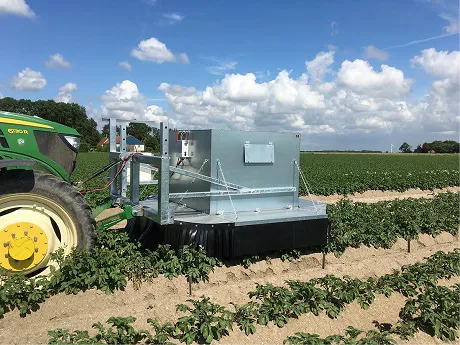In temperate regions, the main diseases of the seed potato crop are caused by viruses and bacterial infections (Dickeya and Pectobacterium). In the Netherlands, the world’s major supplier of certified seed potatoes, these two diseases are responsible for an average 14.5% declassification of seed lots (over the period 2009–2016) and an average 2.3% rejection. This results in a total value decrease of almost 20 million euros per year for all Dutch producers.
A potato crop can be infected by various viral pathogens resulting in a broad spectrum of different symptoms. PVY (genus Potyvirus, family Potyviridae), is one of the most prevalent and important viruses in potatoes globally and is in the top–ten of most damaging plant viruses. Different strains of PVY have been identified that vary in symptom expression, including mosaic leaf discolorations caused by PVYO, stipple streak caused by PVYc, necrotic leaf spots caused by PVYN and PVYNTN and necrotic spots on tubers caused by PVYNTN.
"When a virus is found in the field, virus-diseased plants lead to declassification or even rejection of the seed lots resulting in a financial loss. Farmers try to detect diseased plants and remove virus-diseased plants from the field. Nevertheless, dependent on the cultivar, virus-diseased plants can be missed during visual observations in particular in an early stage of cultivation. For these reasons, there is a need for fast and objective disease detection system", the scientists of Wageningen University & Research explain.
Early detection of diseased plants with modern vision techniques can significantly reduce losses and costs. "Previous laboratory experiments showed that hyperspectral imaging clearly could discriminate healthy from virus infected potato plants - the experts continue - We conducted a study focusing on the detection of PVY infected potato plants using hyperspectral imaging and deep learning. A novel FCN (fully convolutional neural network) is used to detect plant diseases based on hyperspectral image data".
 System while doing field measurements. The measurement system consists of two compartments, the first one for the hyperspectral camera and the second one for an RGB-D imaging system. Ambient light is blocked by two rows of rubber flaps. The system can be mounted on the front of a tractor.
System while doing field measurements. The measurement system consists of two compartments, the first one for the hyperspectral camera and the second one for an RGB-D imaging system. Ambient light is blocked by two rows of rubber flaps. The system can be mounted on the front of a tractor.
The trained network was validated on different potato cultivars. From the comparison with conventional disease assessment results the suitability of this imaging method for real-world disease detection.
Source: Polder Gerrit, Blok Pieter M., de Villiers Hendrik A. C., van der Wolf Jan M., Kamp Jan, 'Potato Virus Y Detection in Seed Potatoes Using Deep Learning on Hyperspectral Images', 2019, Frontiers in Plant Science, Vol. 10.
